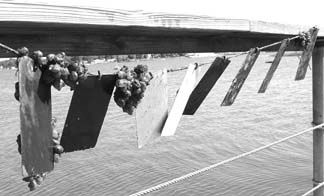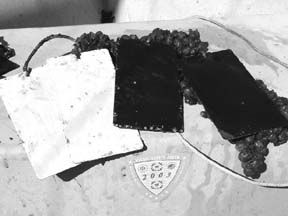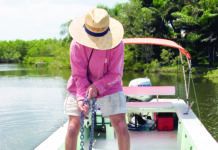We reported in the August 1, 2003 issue on the phasing out of tributyltin (TBT) as the biocide of choice for antifouling paints. While this was a great move for the environment, it posed a particular challenge for paint manufacturers designing products for use on metals: how best to protect underwater metal structures from organic fouling while avoiding destructive galvanic interaction between the submerged metals and the most common copper-based replacements for TBT.

As sailors, we’re concerned, or should be, about long-term environmental issues, but we also need to know what kind of performance we can expect for the coming season from the first post-TBT offerings of various manufacturers. We set up an experiment to seek some of the answers.
Painting of any kind is more than technique and result. The painting experience itself can be positive or negative according to such factors as expectations, expertise, and technical requirements, as well as the quality of the products and guidance provided by the manufacturer. For the present experiment, we put non-experts to the task of applying antifouling coatings to the aluminum test surfaces, for the purpose of evaluating the effectiveness of the result as well as the quality of the experience.
We took delivery in the spring of a selection of metal antifoulants, some especially formulated for use on aluminum hulls, outboard and Saildrive lower units, and outdrives, and some advertised as being able to work on most any underwater metal.
We tried to follow rigorously all manufacturers’ recommendations for preparing and priming bare metal. Where the requirements weren’t clear, we asked. Each paint or foul-release coating was applied to a number of 4″ x 8″ aluminum test panels supplied by Q-Panel Lab Products. We suspended them all for six weeks in the waters of a local marina in Long Island Sound.
It isn’t easy to pick a preferred approach just by looking at the results we got. Most paints performed well in most aspects, with exceptions noted below, and both of the foul-release coatings, while poles apart in application method, have much to recommend them. Hard fouling, meaning barnacles, was acceptable across the board, and scum was readily removed from all the surfaces. In general, paints applied by brush seemed more resistant to blistering or peeling from properly prepared surfaces, although only one of the aerosols actually loosened significantly.
In making our own evaluations, we considered not only these results, but also such factors as the comfort level that might be expected by relatively inexperienced users with regard to application techniques, the nature of required preparation, and the clarity of supplied instructions. Taking these factors together, we came up with preferences that worked for us.
Interlux Trilux Prop & Drive
We started with aerosol-applied Trilux Prop & Drive in black. Interlux offers this version of Trilux especially for use on aluminum outdrives and outboards, and a single can is normally required for one unit. It incorporates Interlux’s Biolux booster to help control slime. Instructions supplied on the label were exemplary, if somewhat microscopic—a common trait among the products tested.
For our bare aluminum, we were directed to sand with medium grit emery cloth and follow up with an application of Viny-Lux 353/354, an etching primewash that must be allowed to dry for at least one hour but not more than 24—otherwise the application must be repeated.
Two coats of Primocon primer (Interlux YPA985) followed, separated by at least 3 hours of drying time. Two top coats of Trilux finished the job, with a minimum of 6 hours of drying time between.
The process was straightforward and well defined. Everything went on easily, producing an especially appealing, very even matte finish. We dunked the panels and awaited the results.
At the end of the project, the panels treated with Trilux aerosol were virtually clear of significant fouling, with only a few small barnacles. After 30 days, we saw very slight bubbling around the edges. After 45 days, this had not increased, and the surface remained relatively free of marine growth. In spite of the sea grapes and barnacles that took over nearby untreated surfaces, a typical Trilux panel held about 6 to 12 small barnacles. Any slime wiped off cleanly.
Flexdel Aquagard II
Our other aerosol was Aquagard II, also specified for outboards and outdrives. Preparation instructions differed from Trilux’s by omitting the etching primewash and specifying two coats of Aquagard 181 primer with a light sanding in between. Again, two topcoats completed the process. Antifouling performance was typical for our test, with minimal hard fouling and readily removed scum. After 45 days the paint showed some blisters and had lifted away from a portion of the metal surface, starting at one corner. We called Flexdel about this and asked whether an etching phase might be desirable. We were told it should not be necessary on bare metal—stick with cleaning and priming, as per the instructions.
Flexdel has come out with a new version of this product, with Bioshield biocide. They’ve named it Alumi-Koat, which is likely to be confused in the marketplace with Pettit’s Alumacoat name. See below.

Pettit Alumacoat SR (Vivid)
Pettit provided our first brush-applied paint, a white version of their Alumacoat SR, due for introduction in early 2004 under the product name “Vivid,” in several bright colors. Since the prototype packaging didn’t include application instructions, Pettit advised us to follow those for other paints in the product line: the usual sanding, Pettit 6455/044 metal primer, 6627 tie-coat, and two top coats. The resulting finish, although not as smooth as the aerosols, was very good.
Pettit’s Alumacoat SR allowed a moderate number of small barnacles, a total of 14 on the 4″ x 8″ panel. We detected no blistering, cracking, or peeling over the life of the project for this or any of the brush-applied products. About a dozen small barnacles did manage to hang on to each of the panels, but the scum was especially easy to clear away.
E Paint EP-ZO, EP-SN1, EP-21
The three brush-applied paints from E Paint arrived with the required two-part primewash and epoxy primer with converter, marked “For industrial and professional application only.”As would be expected, product information was extensive but more suited to professionals than first-timers, and the instructions had us keeping our places in various sections of labels and printed sheets while we consulted others.
The wash primer differed from others in being supplied as a base and activator, requiring a 7:1 mixture. Likewise, the tie-coat primer was an epoxy requiring a 3:1 mixture with its supplied converter. We were directed to apply each of the paints when the epoxy coat was still “slightly tacky and soft to finger pressure,” which our monitoring showed to occur just after three hours.
Antifouling performance of all three paints was superior. The main difference among them was in the smoothness of the initial brush-applied coating, with EP-ZO the most satisfactory. And it showed only two small barnacles after 45 days in the water. EP-SN-1 showed no barnacles at all—probably attributable to the high-performance Sea Nine biocide—but was more affected by slime, which wiped off easily.
EP-21, a nonbiocidal, photoactive barrier coating, had a bit of both barnacles and slime, but still showed excellent performance. E Paint recommends this formula particularly for use on small vessels and outdrives. As expected with the etching primewash and epoxy primer, none of the E Paint coatings showed any evidence of blistering or peeling. While EP-SN-1 and EP-21 can be spray-applied, this is a job for professionals. In fact, EP-SN-1 is available only through commercial yards. None of the E Paints is available as an aerosol.
Easy On Bottom Coating
This is a biocide-free barrier system from Philadelphia Resins that allows for the periodic cleaning of light fouling throughout the season “in all fresh water and intermittent saltwater applications.” The name Easy On aptly describes the method of use: Wipe it on. Period. (After washing, rinsing, and drying the surface, of course.) Supplementary instructions are to “Clean during season with sponge or deck brush.”
We experienced light fouling after three weeks, but it easily wiped off. Fouling left for six weeks would have been less if the surface had been wiped more frequently. Periodic wiping isn’t always practical, but if that’s something you can do—and especially if you have a chance to apply further coatings during the season—Easy On offers a good results-to-effort ratio.
Interlux Veridian
Like Easy On, Veridian is a foul-release product with no biocide. It sets up as a silicone-rubbery covering, and allows light fouling to be cleaned by the friction of the boat moving through the water, or by periodic use of a cloth or sponge. Unlike Easy On, it requires rigor in its relatively complex application process. It’s supplied as a three-part system—a tie-coat primer, followed by an applicator-combined topcoat base and curing agent. It’s generally sold in a quantity suitable for an average lower unit or Saildrive. Since total film thickness is specified as the most important factor in the success of the system, a thickness gauge is included. The supplied mixing bag makes the 3:1 ratio of topcoat to curing agent a sure thing.
Our clear-coat showed the expected light fouling, as well as some discoloration from deposits left in place over a long period. Whether we removed the fouling early and easily, or later with more effort, the original rubber-like coating remained viable. Veridian performed as expected, with the bonus of providing some relief for the environment.
The Bottom Line
There’s no doubt that the performance of all our coatings would have been enhanced by more frequent vigorous motion through the water throughout the season, rather than remaining on mostly stationary test panels. That would have taken better advantage of slime-reducing, foul-release, and ablative properties.
Even so, the performance of all three E Paints could hardly be faulted, and in their rejection of shell growth they were a cut above the others. They are not as widely available or as simple to apply as Interlux and Pettit, and EP-ZO and EP-SN-1 are a bit pricier for small applications. They do offer a most attractive choice, particularly for users with an above-average experience level, or those who are having the job done professionally. The EP-21 is an economical and effective option.
Interlux Trilux is readily available, in a single can for a single application. It’s not at all tricky to apply, and produced excellent results. We presume that an aerosol version of Pettit’s Alumacoat SR would perform similarly, but such a product has not been announced. As with any aerosol, special attention to sanding and careful preparation will repay the effort.
Both of the foul-release coatings did a pretty good job. Easy On provides a simple and useful alternative to painting for those who value the convenience and environmental value. Veridian, which requires more care in application, is still easy enough to work with, and would provide a much longer-lasting surface.
Also With This Article
“Value Guide: Underwater Metal Coatings.”
“And the Dolphinite?”
Contacts
• E-Paint Company, 800/258-5998, www.epaint.com
• Flexdel Corp., 888/353-9335
• Interlux Yacht Finishes, 800/468-7589, www.yachtpaint.com
• Pettit (Kop-Coat) 800/221-4466, www.kop-coat.com
• Philadelphia Resins, 215/855.8450, www.philadelphiaresins.com

































